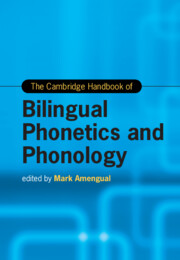Book contents
- The Cambridge Handbook of Bilingual Phonetics and Phonology
- Cambridge Handbooks in Language and Linguistics
- The Cambridge Handbook of Bilingual Phonetics and Phonology
- Copyright page
- Dedication
- Contents
- Figures
- Tables
- Contributors
- Acknowledgments
- Introduction Bilingual Phonetics and Phonology
- Part I Approaches to Bilingual Phonetics and Phonology
- Part II Theoretical Models of Bilingual Phonetics and Phonology
- Part III The Phonetics and Phonology of the Bilingual Child
- Part IV The Phonetics and Phonology of the Bilingual Adult
- Part V The Diversity of Bilingual Speakers
- 22 The Phonetics and Phonology of Early Bilinguals
- 23 The Phonetics and Phonology of Adult L2 Learners in the Classroom
- 24 The Phonetics and Phonology of Adult L2 Learners After Study Abroad
- 25 The Phonetics and Phonology of Heritage Language Speakers
- 26 The Phonetics and Phonology of Indigenous Language Bilinguals
- 27 The Phonology of Bimodal Bilinguals
- 28 Comparing Bilingual and Trilingual Phonetics and Phonology
- Part VI Variables and Outcomes of Bilingual Speech
- Index
- References
24 - The Phonetics and Phonology of Adult L2 Learners After Study Abroad
from Part V - The Diversity of Bilingual Speakers
Published online by Cambridge University Press: 14 November 2024
- The Cambridge Handbook of Bilingual Phonetics and Phonology
- Cambridge Handbooks in Language and Linguistics
- The Cambridge Handbook of Bilingual Phonetics and Phonology
- Copyright page
- Dedication
- Contents
- Figures
- Tables
- Contributors
- Acknowledgments
- Introduction Bilingual Phonetics and Phonology
- Part I Approaches to Bilingual Phonetics and Phonology
- Part II Theoretical Models of Bilingual Phonetics and Phonology
- Part III The Phonetics and Phonology of the Bilingual Child
- Part IV The Phonetics and Phonology of the Bilingual Adult
- Part V The Diversity of Bilingual Speakers
- 22 The Phonetics and Phonology of Early Bilinguals
- 23 The Phonetics and Phonology of Adult L2 Learners in the Classroom
- 24 The Phonetics and Phonology of Adult L2 Learners After Study Abroad
- 25 The Phonetics and Phonology of Heritage Language Speakers
- 26 The Phonetics and Phonology of Indigenous Language Bilinguals
- 27 The Phonology of Bimodal Bilinguals
- 28 Comparing Bilingual and Trilingual Phonetics and Phonology
- Part VI Variables and Outcomes of Bilingual Speech
- Index
- References
Summary
Study abroad is typically viewed as a catalyst for pronunciation learning because it affords learners both massive amounts of L2 input and abundant opportunities for meaningful L2 use. Yet, even in such an environment, there is substantial variability in learning trajectories and outcomes. The nature of the target structure is also a powerful determinant of learning; some structures seem to develop effortlessly, whereas others do not improve much at all. Additionally, study abroad research brings to light the important issue of speaker identity, as learners often make decisions about how they want to sound and what pronunciation features they will adopt. This chapter examines developmental time frames, trajectories, and turning points in the phonetics and phonology of L2 learners in a study abroad context. We also describe how learners acquire the regional pronunciation variants of their host communities considering the phonetics of the target feature and learners’ attitudes and beliefs. We argue that study abroad should be situated within a dynamic, longitudinal, and context-dependent view of phonetic and phonological learning.
Keywords
- Type
- Chapter
- Information
- The Cambridge Handbook of Bilingual Phonetics and Phonology , pp. 542 - 559Publisher: Cambridge University PressPrint publication year: 2024

